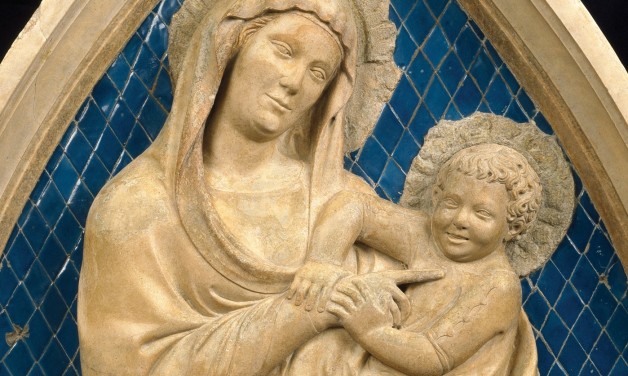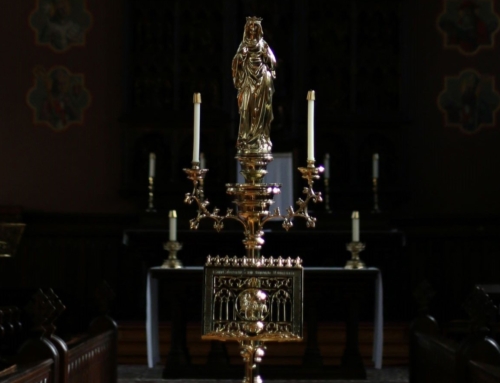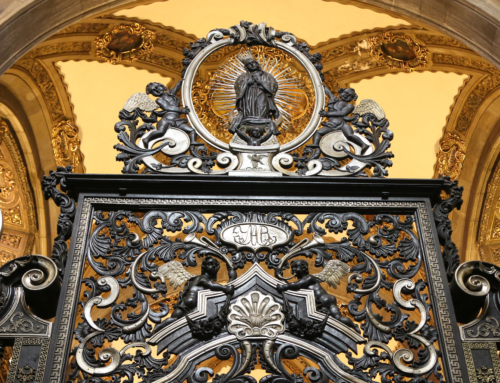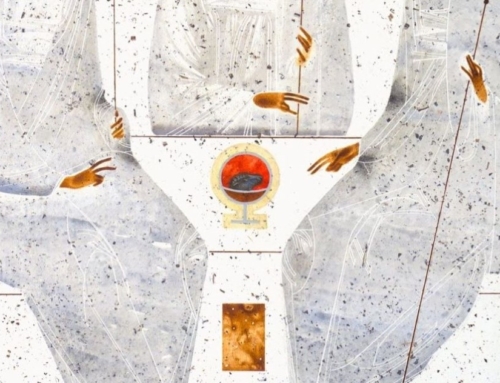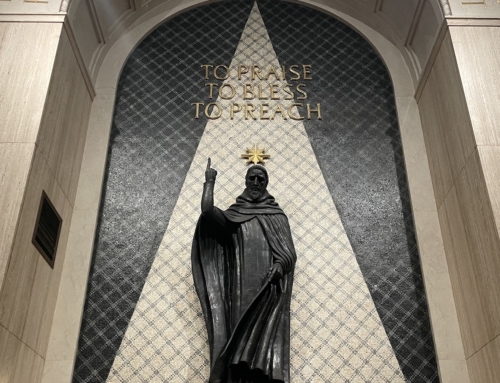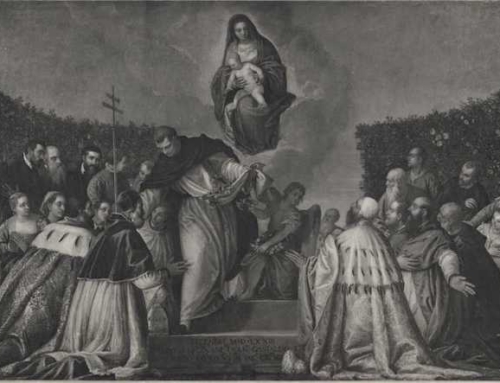When you picture Mary holding the Christ-child, what do you imagine her doing? Gazing into his eyes? Nursing him? Just holding him close? Thanks to the new Picturing Mary exhibit at D.C.’s National Museum of Women in the Arts, you can add another loving mother-son activity: tickles.
This magnificent exhibit of Renaissance and Baroque depictions of Mary covers all the familiar Marian topics, from standard Madonna-and-Child images, to crucifixion scenes, to Mary’s role in Christian life, etc. Amid all that splendor the curators have tucked away two little gems, Andrea Pisano’s bas-relief Madonna and Child (1340) and the painter known only—and promisingly—as the Master of the Winking Eyes’ tempera on the same theme (c.1450). What makes these images so striking—besides the winking eyes—is that, judging from their postures, facial expressions, and hand positions, Jesus seems to be fighting a losing battle against an onslaught of motherly tickles.
Bred as we are among the mountains of solemn and prayerful images of Mary presenting the Christ-child for our adoration, can these artists be allowed the license of depicting Mary and Jesus in such an ecstasy of whimsy? Ought the Orthodoxy Police haul them to prison for their outrageous presumption in showing the infant God-man choking with delight? Yes, we know that the Son of God became man, that he ate, slept, walked, was crucified, died—all these human things we see in the Gospels. These mostly seem fair enough for artistic presentation (although you’ll never find a representation of Jesus eating), but being caught in a fit of filial giggles? Surely this is beneath the divine dignity.

Master of the Winking Eyes, Madonna and Child (Madonna col Bambino), ca. 1450; Tempera and gold on wood panel, 23 1/8 × 15 1/4 in.; Grimaldi Fava Collection
Happily, Pisano and the Master of the Winking Eyes have discovered and shared with us the divine intoxication of God’s true humanity in Jesus Christ, and how radically complete and all-the-way-down that is. When the Word was made flesh, he really became like us in all things but sin; and even then, he took on our sinful nature without suffering its moral brokenness in order to purify, heal, and elevate it, so that through his life, death, and resurrection, every good thing humans do can be a place where they meet Christ. That means that Jesus is as human as it gets: he got exhausted, took naps (although he had nowhere to lay his head), took baths, trimmed his beard, learned to walk and talk, and, as little babies are wont to do, squealed and squirmed with joy during mother-son playtime.
Naturally, not all of the human acts of Jesus are fitting subjects for artistic display, but I think there’s something remarkably liberating about the way that Pisano and the Master of the Winking Eyes offer praise to God by showing the baby King of the Universe getting tickled by the one whom the Father will crown the Queen of Heaven. I’ve spoken elsewhere about why Jesus is never depicted as laughing in the Gospels, and why that’s no reason to insist that Jesus never laughed tout court. Art like these two rare images—neither of which has ever been on American soil before, by the way—enables the beholder to experience in a dim but real way the splendor of Christ’s perfect joy that is constantly hidden in plain sight in the Gospel texts. We can laugh with the giggling, writhing Christ-child because we know that this be-tickled body is the same body that he will offer freely out of love to go hungry, to walk all up and down Israel, to preach the good news, to heal the sick and the blind, to suffer injustice, to be scourged, to be crucified, to die. The same body that is Jesus’ on the cross is on display in these two lovely images; the same humanity is what makes both possible. And in the resurrection, this same body, this same humanity, has risen from the dead and has become all humanity’s path to heaven.
All this, ultimately, is why Pisano and the Master of the Winking eyes have given us a perfect gift for Advent (and, since the exhibit is continuing from December 5, 2014, to April 12, 2015, a perfect Lenten gift, too): they show us that by adoring the God-man in his divine humanity, we are taught how to see him as he is; we are taught to understand the perpetual gift of love that he offers to God every moment of his life; we are taught that the adorable babe we await at Christmas is the same true God and true man who will suffer and die on the cross and be raised on the third day; and we are taught that this same too-ticklish flesh is now reigning forever at God’s right hand in heaven. So I say thanks to these two great artists, and to the National Museum of Women in the Arts for bringing them stateside.
✠
Image: Andrea Pisano, Madonna and Child (Madonna col Bambino), 1340; Carved marble with majolica, 33 × 34 in.; Museo dell’Opera del Duomo, Florence; inv. 2005/407
Both images courtesy of the National Museum of Women in the Arts

